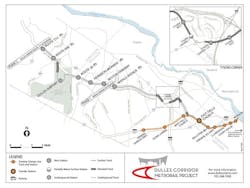Reducing utility risks
A partnership led by the Virginia Department of Rail and Public Transportation (DRPT) is planning a 23-mile extension of its Metrorail, from the Orange Line, near Falls Church, to Rte. 772 in Loudoun County, beyond Dulles Airport.
The $4 billion dollar public-private partnership, known as the Dulles Corridor Metrorail Project, is one of the most complex ever undertaken in the Northern Virginia area. The planned alignment will encounter nearly every utility that supports one of the largest commercial areas in the U.S.
To reduce the risk of conflicts with these utilities, prime contractor Dulles Transit Partners LLC (DTP) turned to TBE Group to provide subsurface utility engineering (SUE) and utility coordination services on the first phase of the project, which extends to Tysons Corner and Reston.
“There are significant utility impacts associated with the project,” said Joe Bissett, TBE’s senior utility coordinator and former statewide utilities engineer for the Maryland State Highway Administration. With many years of utility coordination experience, Bissett serves as TBE’s utility coordination specialist on this project.
“The routing of this heavy transit project through already developed urban areas presents considerable utility coordination challenges,” said Kevin Cronin, PE, DTP project delivery manager. “There are multiple utilities that need to be identified, located and, for some, relocated. Incorporating utility coordination and SUE on this design-build project will reduce the risk of costly utility conflicts.”
In the project’s preliminary engineering phase, TBE provided utility coordination services on a variety of utilities, including fiber-optic networks, gas, water, extensive stormwater, wastewater and government-secure communication lines and other related utility appurtenances.
Utility coordination key tasks included records research and information gathering, potential utility conflict identification, conflict analysis using SUE principles, utility relocation engineering, federal and state utility relocation reimbursement, and utility relocation agreements. In the design-build phase, utility construction and post-construction inspection will be performed by others.
TBE performed required SUE services in three phases: Quality Level D (QL-D) records research, QL-B designating services and QL-A utility locating (test hole) services. While using a variety of surface geophysical prospecting instruments to perform QL-B at selected locations, TBE found that in many instances the composite plans showed utilities more than 10 ft away from their actual horizontal location.
In several instances, utility owners had existing facilities that did not even appear on their record drawings and, thus, were not on the composite plans. Had the design proceeded based only on the as-built information, significant impacts with existing utilities would have ultimately occurred, causing costly design and construction delays.
Taking into account TBE’s subsurface utility engineering data, DTP has now completed Phase 1 preliminary engineering. Final design expected to begin in the fall of 2006, with construction scheduled for 2007.
